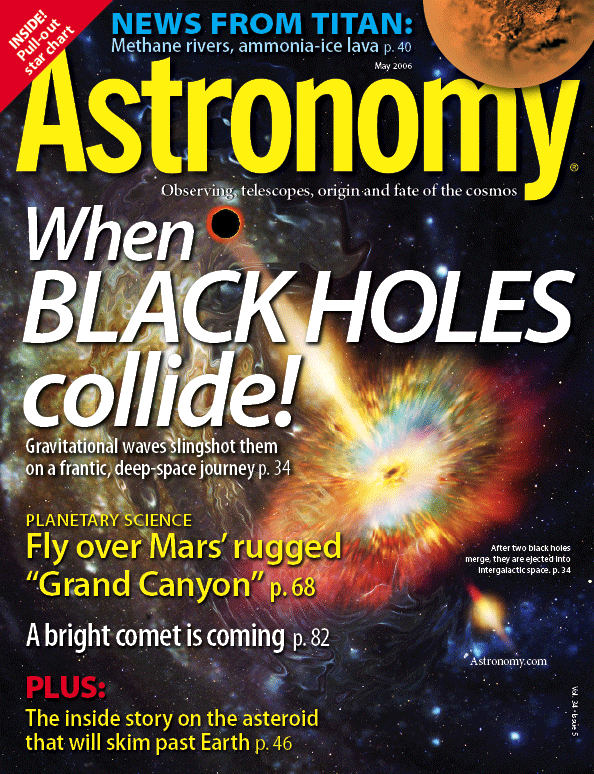
The May 2006 Astronomy will be on newsstands Tuesday, April 4. Credit: Don Dixon for Astronomy.
Astronomy news
This week’s sky events
Astronomy basics
Glossary of astronomical terms
Return to Astronomy “For the media” page March 28, 2006
WAUKESHA, WI – The escapades of Alex Forrest (Glenn Close) and Dan Gallagher (Michael Douglas) in the 1987 thriller Fatal Attraction earn a G rating when compared with what could happen if Earth and asteroid Apophis tango. In Astronomy‘s own “Fatal attraction,” Bill Cooke, an astronomer at NASA’s Marshall Space Flight Center, describes how the asteroid will pass within 22,000 miles (35,200 kilometers) of Earth in 2029. That brings Apophis 10 times closer to Earth than the Moon. According to estimates, Apophis – a few hundred yards wide – has a 1-in-10,000 chance of striking Earth Friday, April 13, 2029. That’s as likely as finding a four-leaf clover on your first try.
Depending on its exact course, the asteroid may return with vengeance in 2036.
The close approach in 2029 presents scientists with a once-in-1,000-years opportunity to study a near-Earth object. Although not as large as the “dinosaur killers” (1,100 yards or more across), Apophis could have more striking power than hundreds of megatons of TNT and could lay waste to large metropolitan areas.
“Saturn’s Titan reveals earthlike surprises”
While NASA’s Cassini spacecraft flies circles around Saturn and its moons, data from one of its former passengers – the European Space Agency’s Huygens probe – reveals earthlike surprises on Titan, Saturn’s largest moon. Huygens’ 2 hours, 27 minutes, 13 seconds of descent data and 1 hour, 12 minutes, 9 seconds of surface data have revealed methane rivers and possible volcanoes on Titan.
In “Saturn’s Titan reveals earthlike surprises,” Bashar Rizk, leader of Huygens’ Descent Imager-Spectral Radiometer imaging team, explains how no other place in the solar system reflects what we see on our home planet as well as Titan. Images from Huygens’ descent and its time on the surface provide a close-up look at this strange, compelling moon.
“Searching for signs of life”
Astronomers seeking life on other worlds first must understand how Earth appears from far away. “Somewhere not too far away in the Milky Way Galaxy,” writes Sara Seager, staff scientist in the Department of Terrestrial Magnetism at the Carnegie Institution of Washington, “an alien civilization may have advanced space telescopes trained on Earth.”
Recognizing intelligent life on Earth is harder than you think.
“What happens when black holes collide?”
While most of us know about black holes and their swallow-up-everything-in-their-cosmic-path habits, few of us imagine them crashing into one another. Astronomy magazine contributor Steve Nadis investigates this phenomenon in the cover story for the May 2006 issue.
For more than 2 decades, professional astronomers have pondered the outcome of two black holes colliding. The leading theory suggests two black holes become one, then get shot out of the galactic center – and possibly the galaxy itself – by a gravitational-wave rocket. This fascinating article includes stunning artwork by Dan Durda that simulates a black-hole merger.
Other stories include:
“Red Planet Rendezvous” – Imaging wizards have combined an ultrasharp photo of Mars’ Valles Marineris and powerful software to produce a stunning aerial tour of the solar system’s grandest canyon. Fly over Mars’ rugged Valles Marineris and witness mammoth landslides, steep cliffs, and whirling dust devils.
“The little comet that might” – Uncertainty about how bright Comet 73P/Schwassmann-Wachmann 3 will be makes it a must-watch object this spring. This comet rides high in the northern sky and peaks in brightness during May and June. At its closest, May 13, Comet 73P/Schwassmann-Wachmann 3 cruises less than 7 million miles (11.3 million km) from Earth.
“All about the Whirlpool Galaxy” – For amateur and professional astronomers alike, this face-on beauty ranks as a celestial showpiece.
“Astronomer for a night” – Kitt Peak National Observatory provides a unique fantasy camp for amateur astronomers. Astronomy‘s Copy Editor, Laura Baird, details her night at this world-class facility.
The May 2006 Astronomy also includes Ask Astro, Astro news, Beautiful universe, Bob Berman’s strange universe, Glenn Chaple’s observing basics, Phil Harrington’s binocular universe, The sky this month, and Reader gallery. Astronomy‘s mission:
Astronomy promotes the science and hobby of astronomy through high-quality publications that engage, inform, entertain, and inspire.
For more information, contact:
Matt Quandt
Assistant editor
Astronomy magazine
[t] 262.796.8776 x419
[e] mquandt@astronomy.com









